Research Focus
The aim of group is to link and control both structures and dynamics from microscopic to mesoscopic and macroscopic length scales in systems ranging from ʽsimpleʼ liquids to various soft materials such as polymers, emulsions, gels, foams, colloids, liquid crystals, and their biological counterparts. Our investigations employ a combination of theory, simulations and experimental techniques to model and build complex and structured materials with desired functionalities and microstructures.
Active areas of research are:
- Rheology and microrheology of complex fluids
- Engineering of micro/nano particles
- Anisotropic particles suspensions
- Active colloids
Rheology and microrheology of complex fluids
The rheological response of soft materials is explained starting from microstructural arguments. In each system, the fundamental mechanisms involved are identified in order to control their rheological behaviour. Experimentally, microstructural information are obtained via direct (optical and fluorescent microscopy coupled with microfluidics) and indirect (small angle light scattering) techniques. Moreover, we employ optical tweezers as a way to locally measures colloidal forces of the order of few pico-Newtons and to perform active micro-rheology. Currently, efforts are focused on developing new methodologies to extract interfacial rheological properties via non-invasive micromanipulation with optical tweezers. Also, we are also interested in probing in biological systems (cell, bacteria and algae) and their local interactions (e.g. adhesion forces and chemotactic response).
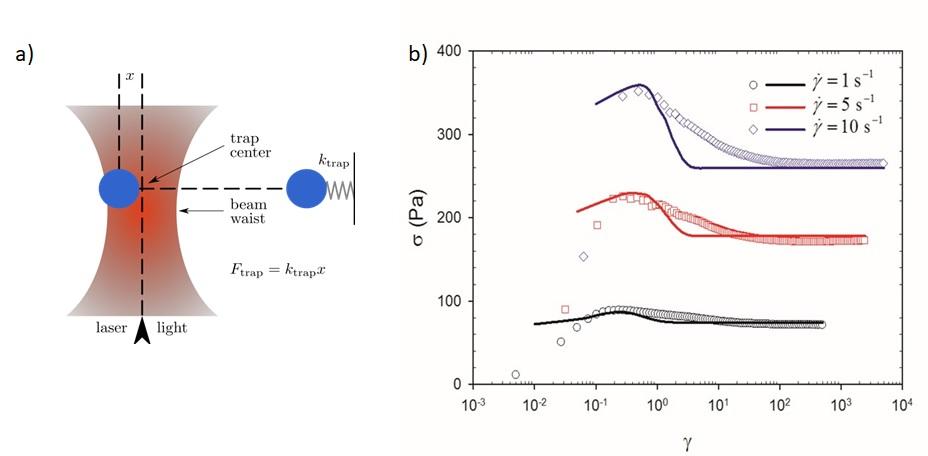
a) Schematic of Optical trapping and b) Shear stress start-up curves of concentrated carbon-nanotube suspensions. Solid lines are theoretical predictions.
Engineering of micro/nano particles
Micro and nanoparticles are used in a wide range of applications from enhance oil recovery and drilling fluids to medical imaging, drug delivery, and beauty and personal care products. We engineer micro and nanoparticles to introduce multiple functionalities on the same particle. For example, we developed magnetically responsive nanoparticles, self-propelling Janus (from the two faced Roman God) micro particles that are pH responsive and amphiphilic particles (possessing both hydro-philic and -phobic functionalities) to generate particle stabilized emulsions (Pickering emulsions).
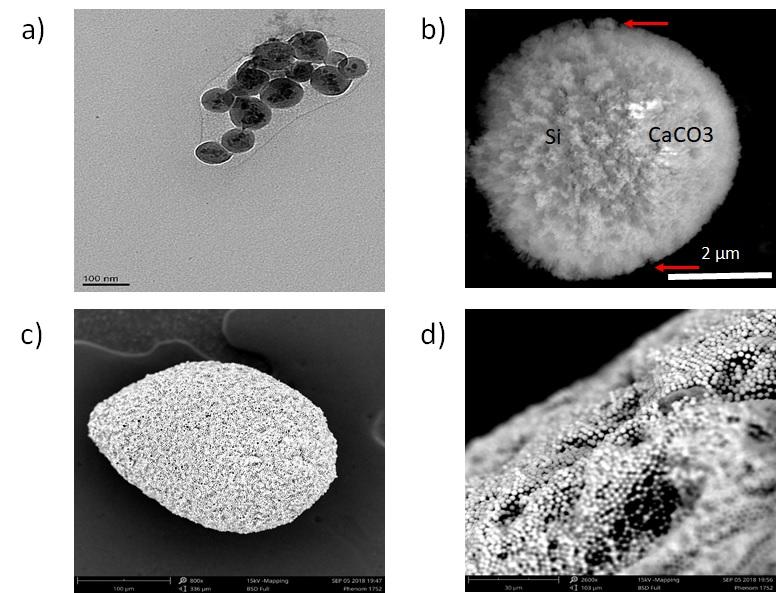
a) Magnetite core and silica shell nanoparticles; b) Calcium carbonate Janus; c) Amphiphilic Silica microparticles stabilizing a droplet of wax; d) Interface of a wax droplet coated with a monolayer of Silica microparticles.
Anisotropic particles suspensions
Anisotropic particles such as carbon nanotubes, nanoclays, nanowires, carbon and glass fibers and many more, are elongated objects with high aspect ratios. They are often present in oil-sands operations (tailings) as well as in biological systems, for example E.coli bacteria. Moreover, carbon nanopartilcles (e.g. carbon nanotubes and graphene) and metal nanowires are particularly interesting as polymer filler to create multifunctional composite because of their thermal, electrical and magnetic properties. Focus is dedicated on how to relate particles microstructures to the macroscopic properties of materials as well as how external (flow, magnetic and electrical) fields can control particles orientational and spatial organizations in complex fluids.
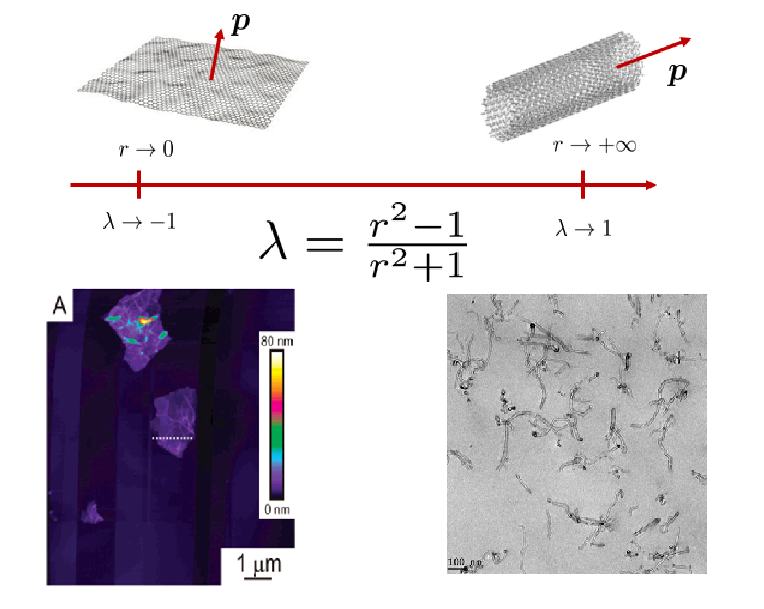
Schematic showing the two extremes of the aspect ratio regime of anisotropic particles.
Active colloids
Active colloids are self-propelling particles which transform chemicals, light radiation or thermal energy into motion. Many potential applications are now within reach: from cargo particle in drug delivery to micromixers and mobile probes for biosensors. Their dynamics ranging from the single particle perspective to their collective motion is studied. Major focus is dedicated on the interplay between medium rheology and active colloids dynamics and on the design of new biocompatible active colloids.
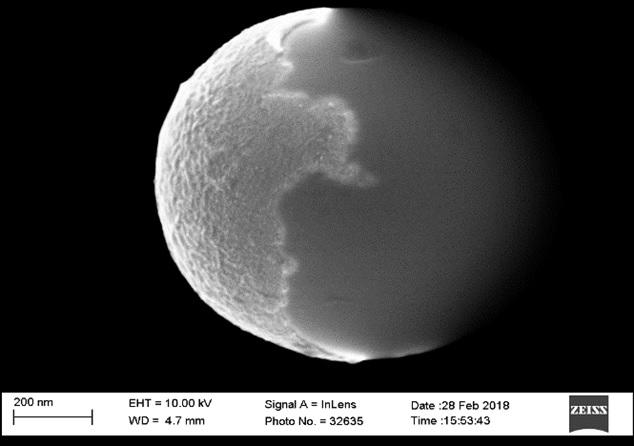
A nanometric layer of Platinum (Pt) coates a silica microparticle. Pt works as an engine to convert chemical energy into motion.
Infrastructure
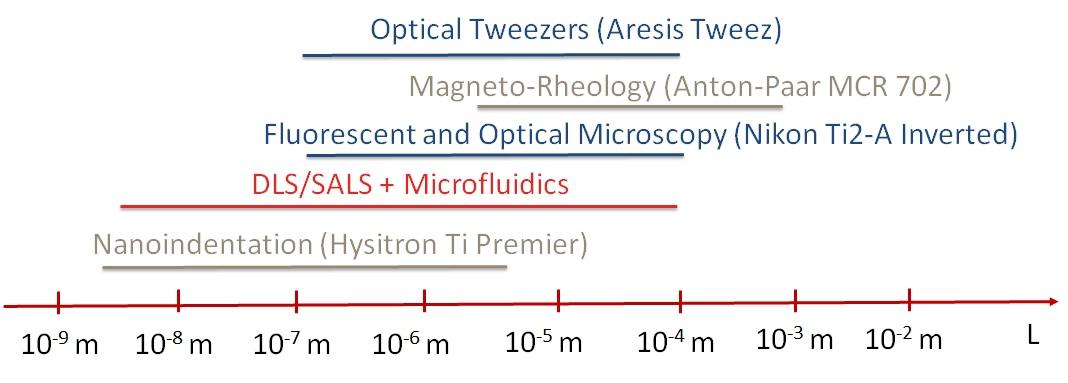
Available Infrastructure and accessible length scales during characterization.
